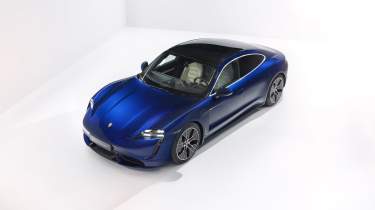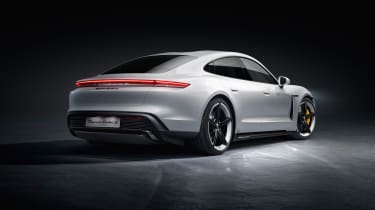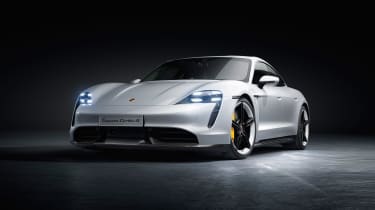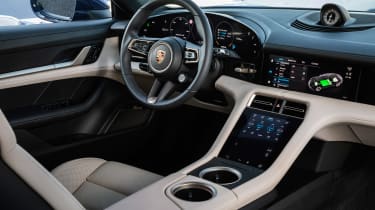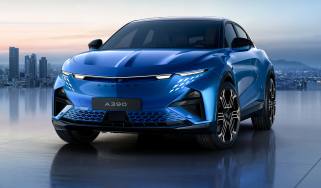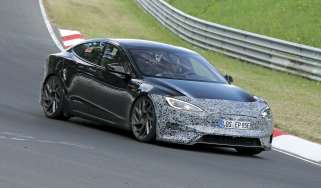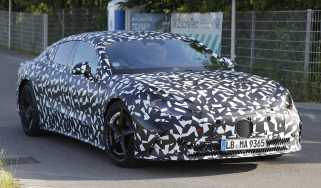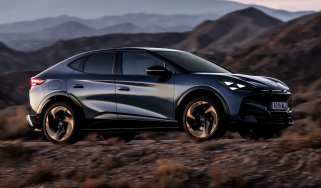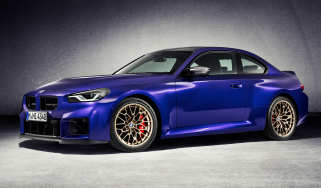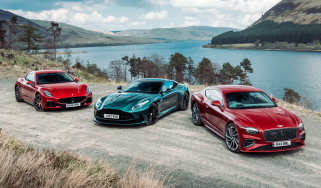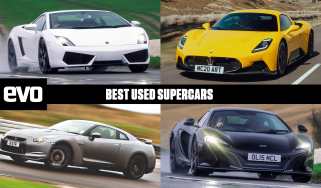2020 Porsche Taycan revealed – 750bhp EV ready to go
Look out, Tesla! Porsche’s production-ready Taycan is finally here, and it doesn’t disappoint
It seems like we’ve been waiting an age for the Taycan, the all-new, bespoke Porsche electric vehicle that is intent on realigning our expectations of battery-powered cars at large. Could this be the first electric vehicle that is a statement not of (questionable) environmental impact aspirations, but of pure and simple capability?
The numbers are big, with Porsche revealing two high-specification Taycans to begin with, dubiously called the Turbo and Turbo S. Rather than denoting any form of turbocharging, instead these titles purely align these variants with other models in the Porsche range. A third Taycan, due to sit beneath the Turbos in the line-up, will follow in the near future.
> Mercedes-AMG electric car to target Porsche Taycan and Tesla Model S
Both of the launch Taycans have somewhat convoluted power figures, with an overboost function able to unlock more performance from each car’s dual electric motor set-up under certain circumstances. The Turbo S’s headline figures stand at 616bhp, with an overboost peak of 750bhp – along with 774lb ft of torque – when launch control is selected. It’ll reach 62mph in 2.8sec, 100mph in 6.3sec and go on to a limited top speed of 162mph. The Turbo, meanwhile, has the same 616bhp in normal driving, but a less potent 671bhp on overboost due to its slightly smaller and less powerful front motor; 0-62mph takes 3.2sec and top speed is the same 162mph.
The sceptics among you might note that the Turbo S’s 0-62mph time isn’t as brisk as that claimed for a top-level Tesla Model S Performance (2.4sec). However, it should be noted that the Taycan’s 2.8sec figure is repeatable at will, without the need to tick on-screen disclaimers or precondition the batteries for several minutes beforehand.
While the outright performance credentials of EVs have now been fully explored by the likes of Porsche and Tesla, along with a raft of electric hypercars, it’s perhaps their range that is of most interest to most buyers. No point in being able to cover ground rapidly if you keep having to stop to recharge...
Of the two Taycans it’s, unsurprisingly, the lower-powered Turbo that can go furthest with a WLTP figure of between 236 and 279 miles on the combined cycle. If driven exclusively in the city that range should increase to just over 300 miles. The more powerful Turbo isn’t too far behind, offering between 241 and 256 miles on the combined cycle and the potential of 293 miles in the city. While the Taycan’s range is impressive, the Long Range Tesla Model 3 can manage up to 348 miles according to its WLTP figures.
Both Taycans share the same basic powertrain design, with bespoke electric motors, inverters, battery management systems and connection methods, all assembled in-house in Zuffenhausen. The permanently excited synchronous electric motors have improved power density and better thermal management compared with other electric motor types. The lithium-ion battery pack is mounted under the cabin floor and has a total capacity rated at 93kWh. It features a charging capability of 270kW – higher than any current charging system in the UK can muster – which Porsche says will facilitate a theoretical recharge of the battery from five per cent up to 80 per cent in just over 20 minutes.
If much of this seems very un-Porsche, the Taycan’s design inside and out is far more familiar, as it adheres to a design language that has been honed over the past 75 years. Despite being lower and shorter than a Panamera, it’s wider and more shrink-wrapped, looking very close to the concept in a very good way. Without the internal combustion engine up front, the Taycan’s scuttle is very low, affording excellent forward vision, the view out framed by haunches over the front wheels. Sound familiar?
The Taycan’s body not only looks similar to the 911’s, but is built in mostly the same way, with mixed-metal construction throughout the body-in-white. The Taycan’s considerable kerb weight instead is due to that battery pack, which results in a figure of 2295kg – some 300kg more than the larger Panamera Turbo, but tellingly still 15kg less than the Panamera Turbo S E-Hybrid. Keeping all that weight in check are standard tungsten carbide-coated brake discs signified by white calipers on the standard Turbo, and full-scale carbon-ceramics with yellow calipers on the Turbo S.
The Taycan’s interior is a new digital variation on Porsche’s usual theme, with a strong horizontal aspect to the dashboard and acres of digital interface made up of two 10.9-inch touchscreens (the second being an option). In front of the driver is a 16.8-inch curved display taking the place of Porsche’s traditional dial set, yet within sits a familiar five-ring layout. Finally, a portrait 8.4-inch display on the centre console controls both the heating and ventilation and acts as an input device for handwriting recognition and as a touchpad. Interior space is limited for four, but thanks to a low seating position, the sloping roofline doesn’t impede as much as you might suspect.
As with all Porsches there’s an extensive list of options available for the Taycan, ranging from wheels with carbon elements at nearly £5k to personalised carbon door sill kick panels at £1900, and if you want to use a public charger you’ll need to shell out over £200 for the cable to do so. Performance-orientated upgrades are less plentiful than on Porsche’s petrol-engined machinery though, but you can still opt for rear axle steering on the Turbo for £1650 or Porsche Dynamic Chassis Control Sport on both models for £2315.
The Taycan, then, is a new type of Porsche – one that the company hopes will appeal to the tech-geek as much as the traditional petrolhead. It’ll be priced at Porsche’s usual level too, with the Turbo starting at £115,858, and the Turbo S a fair chunk more at £138,826. Deliveries will begin in 2020, but be aware that the electric revolution is no longer coming, it’s already here.

